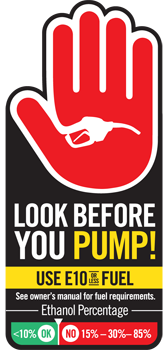- Home
- |
- Find a Dealer
- |
Fuel Recommendations
What kind of fuel should I use in my Honda engine?
Honda engines are certified and designed to run on regular unleaded gasoline.
Gasoline is allowed, by regulation, to contain a variety of additives. The same regulation limits how much of some additives, such as alcohol, can be included in the fuel and still be sold as gasoline. Honda engines are designed for good performance and efficient operation using gasoline containing from 0 to 10% ethanol.
E85 is an alternative fuel. It is not gasoline. It is made by combining 85% ethanol with 15% gasoline. Honda engines are not currently certified or designed to run on E85 or any other alternative fuel.
Always refer to your Honda owner’s manual for a list of recommended fuel and the current approved additives.
How can I avoid fuel related issues?
Specific guidelines vary by model. However, in general, following these steps will help to prevent most fuel-related problems:
-
Do not use gasoline containing more than 10% ethanol in your Honda powered equipment.
-
Store your gasoline in a clean, plastic, sealed container approved for fuel storage. Close the vent (if equipped) when not in use and store the container away from direct sunlight. If it takes more than 3 months to consume the fuel in the container, we suggest adding a fuel stabilizer to the fuel when you fill the container.
-
Keep your engine’s air filter properly serviced. Check it before each use.
-
If you don’t plan to use your Honda powered equipment for more than 30 days, follow the storage guidelines in your owner’s manual. You can also find general storage instructions for your engine here:
How long can I leave gas in the tank?
The length of time that gasoline can be left in your fuel tank and carburetor without causing functional problems will vary depending on a variety of factors.
-
Fuel formulations vary by region. Depending on where you operate your engine, fuel may deteriorate and oxidize more rapidly (in as little as 15 days). Please check with your servicing dealer for storage recommendations and precautions specific to your region.
Other factors include:
-
The air volume in a partially filled fuel tank promotes fuel deterioration.
-
Very warm storage, high humidity and variable temperatures accelerate fuel deterioration.
-
Fuel deterioration problems may occur in less than 30 days, particularly if the gasoline was stored in your portable fuel container for an extended period of time. We recommend that you purchase fresh fuel from a busy, reputable gas station in a volume that will be used in less than 3 months.
Instructions regarding the maintenance and storage of your specific engine model are contained in the STORAGE section of your Honda owner's manual . This section covers all aspects of storage such as adding fuel stabilizer and draining the fuel tank and carburetor, as well as storage precautions and removal from storage.
You can also find general storage instructions for your engine here:
What kind of problems can occur from old gasoline?
In storage, gasoline immediately starts to naturally oxidize and deteriorate. The older it gets the more it deteriorates and the more likely it will cause hard starting and other performance issues that result from sticky deposits that clog the tiny passages in the fuel system.
In addition, ethanol in the gasoline attracts water. Initially it mixes with the ethanol, but at higher concentrations it separates and settles to the lowest point, which leads to corrosion and starting and running problems. The lower the fuel level in the tank, the more likely you will experience water contamination.
If the gasoline in your fuel tank and carburetor has significantly deteriorated during storage, you may need to have the carburetor and other fuel system components serviced or replaced.
Can I use E85 in my Honda Engine?
E85 contains 85% ethanol and must not be used in Honda engines.
Using fuels with percentages of ethanol or methanol higher than 10% (E10) will cause starting and/or performance problems. It can also damage metal, rubber, and plastic fuel system components that are not covered under the Distributor’s Limited Warranty .
Other interesting facts about ethanol
-
Ethanol is produced from corn, soybeans, sugar cane, or other organic material. It is blended with gasoline (10% ethanol, 90% gasoline) to produce E10.
-
Ethanol has 28% less energy density than gasoline, so it reduces fuel efficiency.
-
Ethanol is an excellent solvent, drying agent and cleanser. It will clean or dissolve some parts of, and deposits in, fuel storage and fuel delivery systems, including some fuel tank materials. The dissolved material can clog filters or pass through and leave deposits on fuel injectors, fuel pumps, fuel pressure regulators, carburetor jets, intake tracts, valves, and valve guides.
To help prevent water contamination problems when using a gasoline/ethanol mix:
-
Keep your fuel tank and fuel storage tank filled with fresh fuel and out of direct sunlight.
-
Don’t purchase more fuel than will be used in a 3-month period.
-
Use a fuel stabilizer along with fresh fuel when your engine is stored (follow the procedure noted in your owner’s manual to ensure proper storage). Note that a fuel stabilizer will not reconstitute stale fuel.
-
Use a gas station with a reputation for quality fuel.
-
Know the specific fuel laws for your state as laws and fuel composition may change often.





